Fuet is a Catalan thin, dry-cured sausage made with pork and stuffed in hog casings. The seasonings are very simple - salt, white wine, white pepper and fresh garlic. This particular recipe predates Columbus's return to Europe with a variety of the New World peppers, so no paprika here. Though, it's common to see modern fuet recipes featuring paprika.
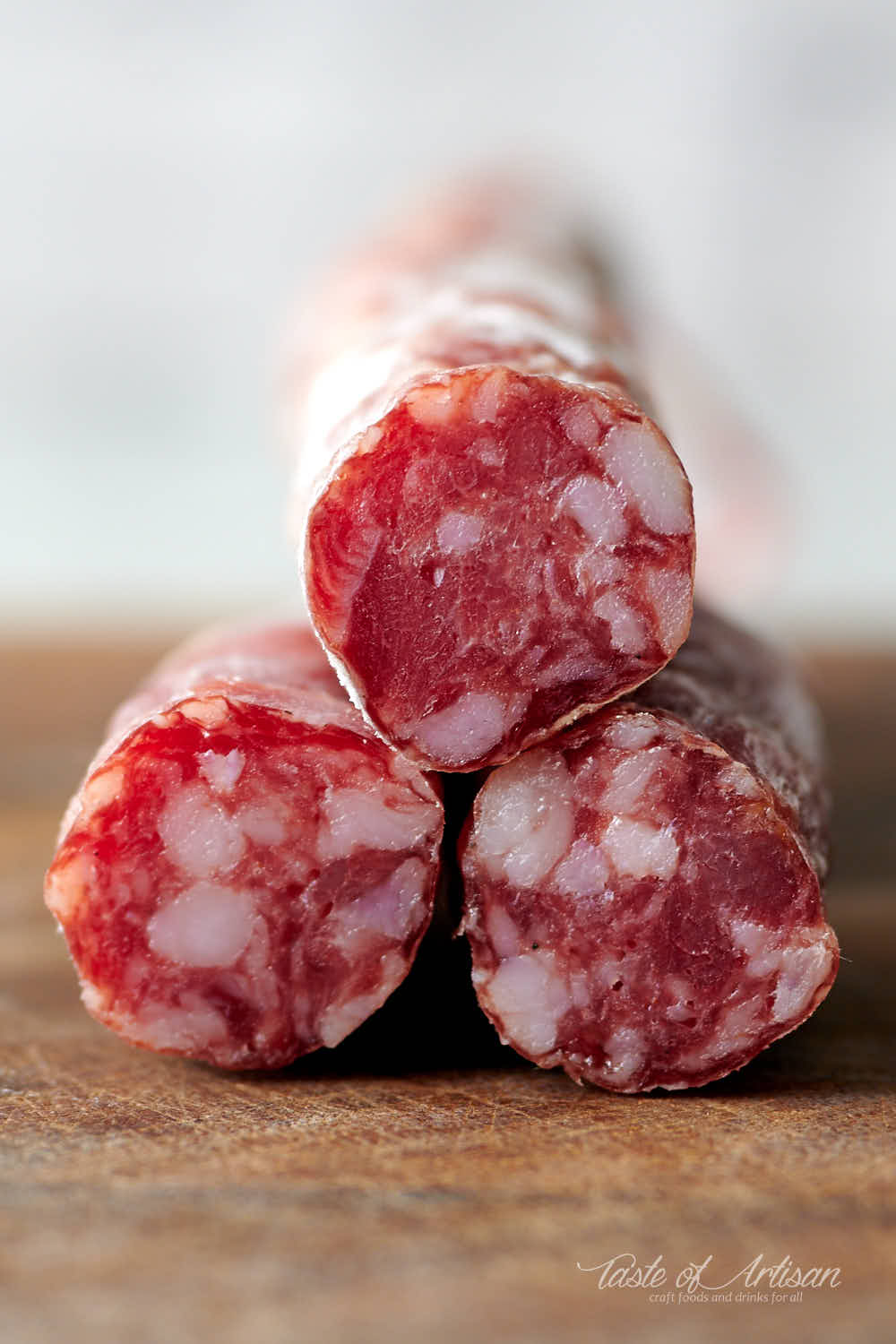
I've been thinking of making fuet since April 2015, when I bought Jeff Weiss's Charcuteria, and saw the recipe and the beautiful picture of the final product in it. Alas, it took me almost 5 years to try my hand at making this sausage. Somehow between trying other exciting charcuterie recipes, designing and building a smokehouse, making a variety of Polish smoked kielbasa recipes, this one inadvertently slipped through the cracks.
Was it worth making? It's a definite yes. It bears a lot of similarities with Italian salami. This wasn't the best tasting dry-cured sausage I've ever tried but it was very good. Garlicky. A touch too salty and a little too acidic for my taste. I would definitely drop the overall salt content from 3.04% to about 2.8%.
Getting the acidity right is a little trickier. Traditionally fermented Italian salami, my favorite, finishes with the pH of about 5.9. pH drops initially, to 5.3 and even lower, then bounces back over time. White mold is critical in reducing acidity. But even if you have a healthy white mold, acidity reduction still needs time.
Since this sausage is very thin, it matures very quickly. I doubt that you could get it to 5.9 before it becomes rock hard. But I do find that 0.6% sugar/dextrose content was a little high. Perhaps dropping it to 0.3%, a more commonly used amount, would give me what I am looking for. My fuet's pH dropped to 5.3 after 22 hours, 1-2 days sooner than the recipe suggested.
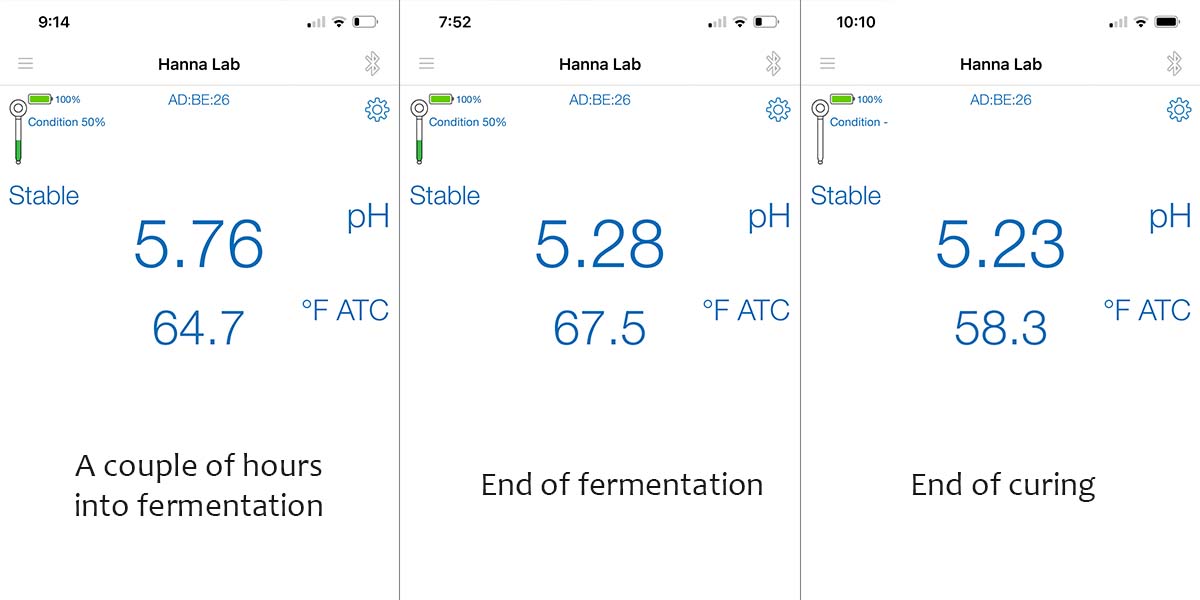
I should have tested it after 10-12 days but I didn't. I have a feeling that it dropped well below 5.3 over time, then recovered a little.
One caveat here is that I used the B-LC-007 starter culture in this recipe. Unlike the T-SPX culture, it does tend to acidify meat pretty quickly. You have to watch the acidity very closely. Perhaps the culture was the culprit in the acidity problem.
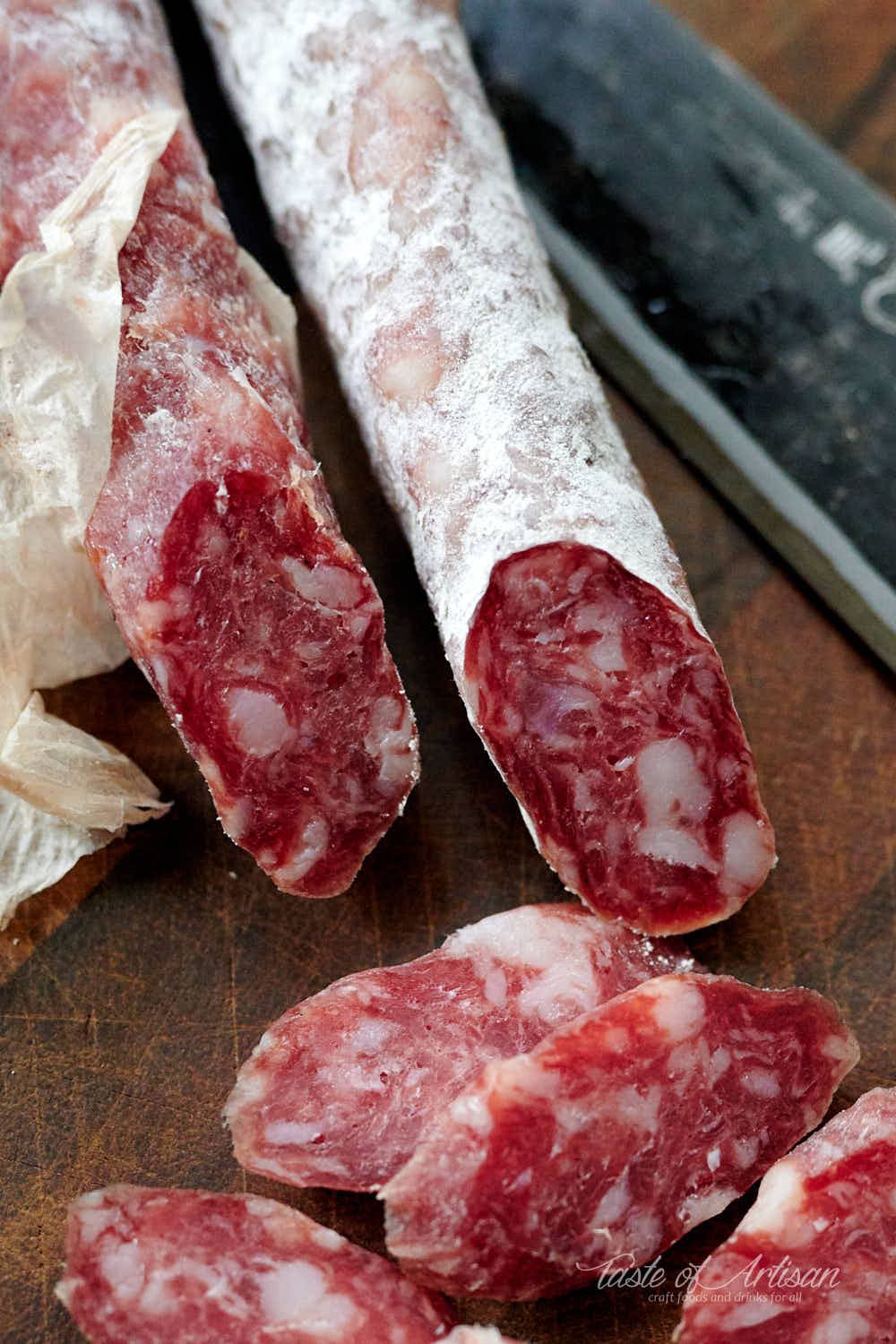
But, really, I am just nitpicking. Overall the sausage turned out quite nicely. My kids and my wife, my most important taste-testers, found my fuet to be outstanding. Fresh garlic comes through very, very well and there is a hint of white pepper spiciness. The garlic drove me nuts during fermentation and initial drying, the smell in the curing chamber was so appetizing. If you love garlic, you will love this fuet. This one might as well be called 'garlic salami'.

The recipe recommends drying to 35% weight loss. I rarely follow those recommendations anymore. Instead, I go by how the sausage feels when you press on it. I like a firm, well-dried texture. By the time my fuet reached that stage, it lost around 45-47% of its weight. It's not hard by any stretch of the imagination though. Firm, but not hard. And delicious! I dried it at about 76% - 78% though, a little lower than the original recipe recommended.
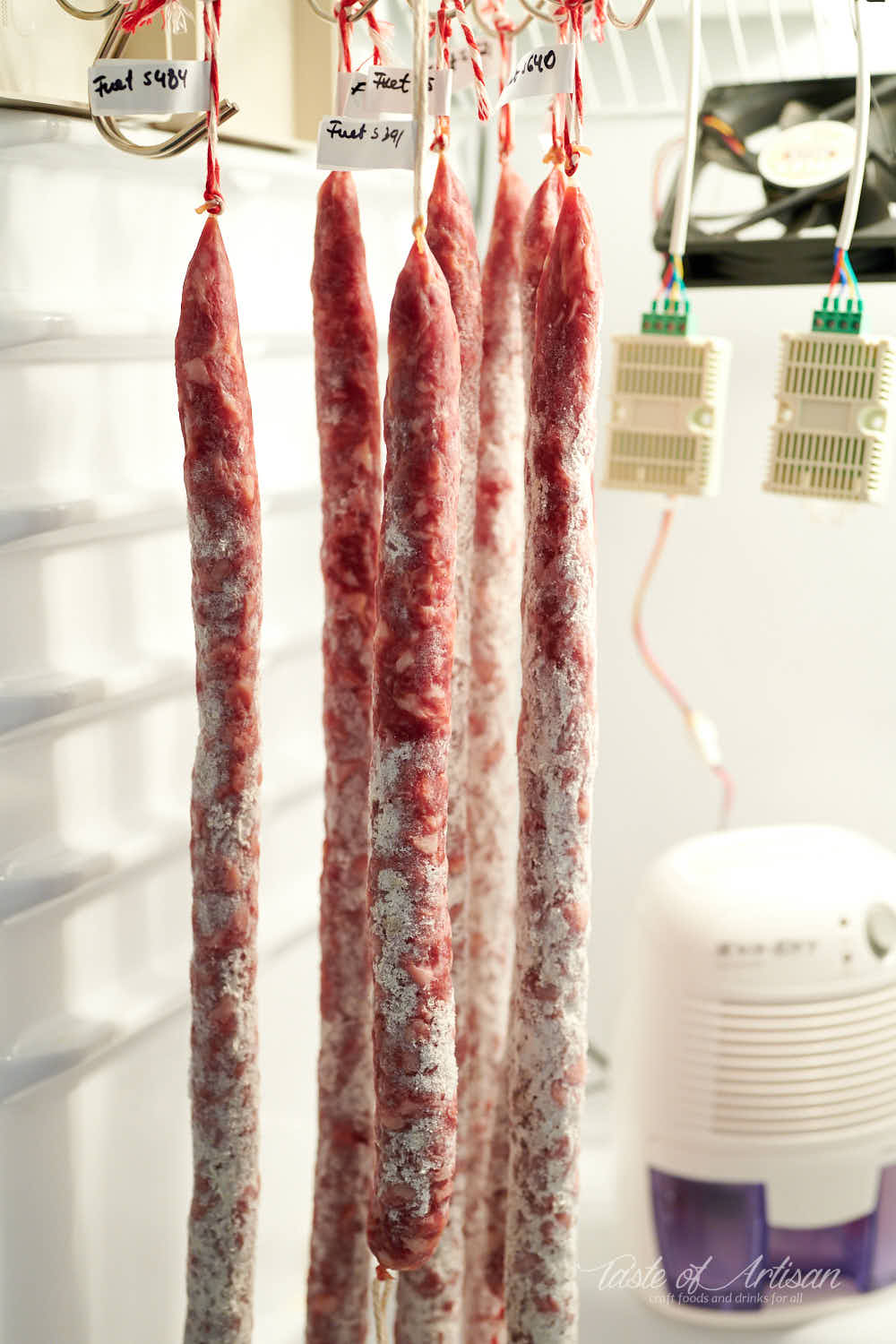
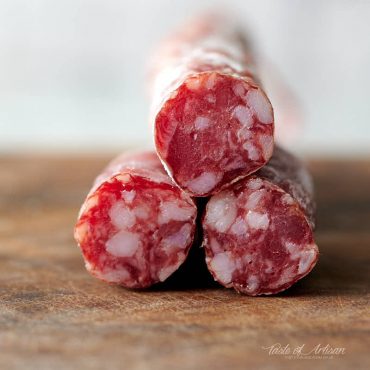
Ingredients
- 400 g lean pork meat
- 400 g coppa
- 200 g pork back fat
- 1 g T-SPX starter culture
- 100 ml water
- 10 g garlic minced
- 28 g kosher salt
- 3 g dextrose
- 3 g granulated sugar
- 2.4 g Cure #2
- 50 ml white wine e.g. Verdejo, chilled
- 5 g ground white pepper
- 2 feet 32-36mm hog casings
Instructions
- Freeze the meat, the fat and the grinder parts for 30 minutes.
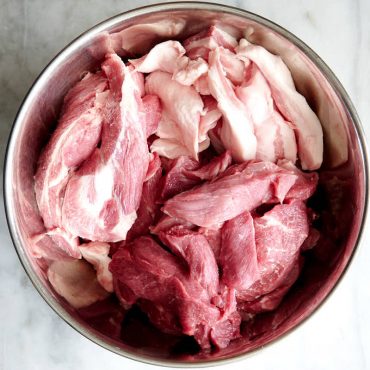
- Add the T-SPX culture to a glass with 100 ml of water and stir. Set aside.
- Crush the garlic with the salt in a mortar using a pestle, creating a slurry. Add the dextrose, sugar, salt, Cure #2 and mix. Divide the mixture in half and transfer to two large bowls.
- Add the lean meat to one bowl and the coppa and back fat to the other. Mix, cover and refrigerate until ready to grind.
- Grind the coppa and the fat through a 3/8" (9.5mm) plate. Similarly, grind the lean meat through a 3/8" (9.5mm) plate into a separate bowl. Freeze the meat and the fat for 20 minutes.
- Grind the lean pork through a 1/4" (6mm) plate. Combine with the ground coppa and back fat.
- In a separate small bowl, mix the wine with the white pepper. Refrigerate until ready to use.
- Place the ground meat and back fat into a bowl of a stand mixer fitted with a paddle attachment. Start mixing on low, slowly adding the wine mixture to the mix. Next, slowly add the starter culture mixture. Continue mixing for 2 minutes, until the meat is sticky. Refrigerate the meat until ready to use.
- Stuff into soaked and rinsed hog casings and tie into long, 18" links. Using a sterile needle, prick any air bubbles. Weigh each sausage and write down the green weight, preferably on a label on each sausage.
- Ferment at 65F to 80F and 85% - 95% RH for 2-3 days.
- Hang the sausages in the curing chamber set to 54F - 60F and 80% - 85% RH for 1-2 months, until the sausages have lost about 35% of their green weight, at which point they will be ready fo consumption.
Nutrition


James says
Hi Victor,
Would you mind clarifying the link length (18") vs the casing length (2 feet, ingredients list).
Should it be 2 meters of casing in the ingredients list?
Victor @ Taste of Artisan says
James, the way this recipe is written, is you need about 2 feet of casings per 1000g of meat. But I'd assume most people will be making batches larger than 2.2 lbs, so, if you do, just tie the links off in 18" lengths. The lengths of the links are that critical, you can make them any lengths you want, with reason of course. Hope this helps.
Pavel says
Victor, hello! I'm interested in your opinion about fat antioxidant, should it be added to sausage or not?
Victor @ Taste of Artisan says
Hi Pavel, I don't add fat antioxidants. Never have, so my recommendation would be not to add it.
Pavel says
Please tell me, can I use the whole pork neck in the recipe, mine is quite fatty
Victor @ Taste of Artisan says
Pavel, it's recommended to use hard fat for salami, like back fat or belly fat, but in this recipe it should work. I've made salami with just pork butt or pork neck and it turned out fine. I personally don't like fatty salami, so lately I've been adding no more than 20% - 25% fat. You may want to trim some fat off, depending on your preferences.
Pavel says
And what would be the best temperature and humidity conditions 55f/75% or 55F - 57F (13C - 14C) and 80% - 82% for coppa and fuet together
Victor @ Taste of Artisan says
It's going to be a compromise one way or the other, but it depends on the timing, too. You want the rate of diffusion (moisture coming up to the surface of the meat) to be equal to the rate of evaporation (moisture being removed from the surface). If RD is greater than RE, you get moist, sticky surface that promotes bad mold growth. If it's the other way around, you get case hardening. So, ideally, you want these two products dried and matured separately. That said, I'd start with 80% and assess as you go. If Fuet is doing well, keep it at that Rh. Otherwise drop it a little and re-assess. You want both to have surfaces that are hydrated, not wet or dry. Hope this helps. Good luck!
Pavel says
Hello! Please tell me if it is possible to dry fuet and coppa together in the same temperature and humidity conditions? I am also interested in whether you have experience drying duck breast?
Victor @ Taste of Artisan says
Hi, if you look at my capicola recipe, there is a drying schedule I follow to get the initial drying done, followed by maturing. A similar drying schedule for fuet would be a little different. After the initial drygin, both can be matured at the same temp/humidity. That said, you can follow a simple method where you give each a fermentation period then dry cure at 55F/75%. I like my method a little more, but both can produce good results.
No, I've never done duck breasts. Good luck!
dugan says
Great post and great blog- sorry if this was asked before ...
When you say 400g coppa
do you mean coppa cut from a pork butt or do you mean real coppa cured coppa?
Victor @ Taste of Artisan says
Dujan, I mean the coppa cut, also known as the pork neck or the 'money muscle';)
Leo says
hello,
1g of T-SPX starter culture on 1 kg of meat?? Isn't it too much?
Victor @ Taste of Artisan says
Leo, in the book, he even suggests 2.4g per kilo of meat. No, it's not too much. If you put too little, you risk the culture not starting quickly enough while unwanted bacteria may take over. It's always better to put a little more than less. Bacteria will multiply during fermentation anyway...
Heinz Lauer says
Just an observation....
Under # 2 mix the T-SPX culture with water and set aside....
You should add it to the meat when you combine everything in the mixer. It's not doing any good sitting aside 🙂
Why do you mix the white pepper with wine and not add it to the other spices?
Great looking product, btw.
Heinz
Victor @ Taste of Artisan says
Ah, good catch, corrected.
As to mixing the pepper with wine, I just followed the original recipe. Maybe it has to do with hydrating the pepper with wine... don't know.
Radu says
Thank you for your observations, Victor!
Indeed, theory it's good, but practical experience counts more in the end!
Radu says
Hi Victor,
Greetings from Romania! Excellent information on your site!
It looks like we have pretty similar hobbies - cooking in general, dry cured meats, sourdough bread, brewing, etc...
I would like to make a general observation regarding the acidity and pH drop for all dry cured sausage: the pH drop depends mainly on the quantity of sugars added; more sugars added, more lactic acid will be produced and consequently lower pH will be achieved. So in order to play with the level of pH drop, we only have to play with the quantity of sugar added.
The difference between using a fast fermenting culture and a slow fermenting one, is that the pH will drop faster in the first case and slower in the second one, but the level to which it drops, it's mainly dictated by the percentage of sugar added.
Regarding the type of sugar to be used, dextrose it's the first choice because it is fermented by all selected cultures. The sucrose, it's not fermented by all selected cultures and if it is not, than it's left at the discretion of the uncontrolled bacteria present in the meat and thus a risk of spoilage!
Victor @ Taste of Artisan says
Hi Radu, thanks for your input. In theory, yes, the amount of sugars will influence the level of acidification but in reality, things tend to get a bit more complex. Here is an example for you: I recently made several batches of different types of salami using the same culture and the same ratio of dextrose, and they all had different finishing pH. How efficiently cultures process sugars is also a factor. I recall one time making three batches of the same salami, identical in every way but different cultures. All three reached different pH levels at 3, 5 and 10 days, and all three finished with different pH levels upon maturity. So, clearly, the amount of sugar is not the only factor. Even though you may think that sugar is the primary factor, other factors may have a significant impact as well.
Frank Sweeney says
I am curious about the possibility of fresh garlic bringing some unwanted hitchhikers to the party
Victor @ Taste of Artisan says
I think curing salt should take care of that... I had a similar concern but thought I'd give it a try anyway... no issues. Maybe try roasting it to get rid of those hitchhikers on the surface... besides roasted garlic would add another dimension... now that I am thinking about it I am definitely going to try that myself.
Pavel says
Hello Victor! Is it possible to use fat antioxidant?
Victor @ Taste of Artisan says
I can't comment on that as I've never used any. I generally try to use as few additives as possible, limiting them to curing salt and bacterial cultures.
Robert says
I love your photos Victor. Was trying to figure out why the sliced Spanish Fuet photos look so good and realized part of it is slicing the pieces on the diagonal. Appearances count, so I'll have to try that.
A quick question - the ingredients call for lean pork meat. What was your source - pork loin or maybe just lean cuts from a pork shoulder?
Victor @ Taste of Artisan says
Thank you for the compliment, Rob. Lean parts were, indeed, cuts from the pork shoulder.